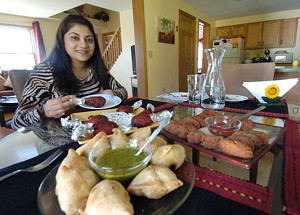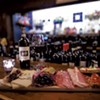Published January 12, 2011 at 6:08 a.m.
It’s not easy to find good, authentic Mexican food in Vermont. Home-cooked Indian and Normandy-style cuisines are also depressingly scarce. Recently, a collection of cooks has taken the first step to fill the gap. Despite tough economic times, ethnic start-ups seem to be bursting out all over, and they have one thing in common: There’s nowhere to sit.
These small businesses avoid the overhead of waitstaff and the countless inspections that come with running a full-service restaurant. This week, Seven Days’ food team tastes some of the best. Alice Levitt visits three area cooks who specialize in Mexican meals. Don’t expect crunch wrap supremes from these take-out spots; they proffer the real deal. Corin Hirsch heads to Montpelier for Indian and Nepalese nibbles and to Greensboro for savory French tarts. Though these places may soon offer sit-down service, where better to enjoy delicious home cooking than at home?
Movable Mexican
Vermont takeout goes south of the border
The Mad Taco
2 Village Square, Waitsfield, 496-3832
You can tell a lot about a chef by his tattoos. Joey Nagy has a slew of them: Miss Piggy looking as though she is about to rip Kermit apart with lust; a hog divided into cuts of meat. That’s right, they’re all pigs.
Nagy admits that when he devised the menu for the Mad Taco — his collaboration with the owners of his former stomping grounds, Three Penny Taproom in Montpelier — he had to force himself to include nonpork dishes. His fondness for the other white meat didn’t develop in a vacuum. The California native spent time as a child eating tacos and carnitas with his uncle in Guadalajara and Mexico City. He says that, especially in the southern part of Mexico, the pig is king. At the Mad Taco, even the beans once oinked — Nagy says he can’t get enough of his refried version, filled with “hot pork fat.”
Nagy left California for Vermont last winter to head the kitchen at Three Penny and quickly identified a dearth of his favorite soul food. He says he was determined to open Mad Taco to fill the void: “I’d be able to eat this food whenever I want.”
Though Mexico and California provide inspiration for Mad Taco’s cuisine, Nagy emphasizes that his dishes were conceived to showcase local ingredients. Everything, from the bread for sandwiches (tortas) to kimchi, which adds a punch to tacos and tortas, is made in-house.
The only things not homegrown are ingredients that simply can’t be. “I can’t get an avocado in Vermont,” Nagy points out. Nor can he get the fresh mahi mahi that he uses with that avocado in his fish taco. Even in January, Mad Taco’s wraps recall summer, all brightness and light, with a strong lime flavor fortified by the tang of vinegar-based cabbage slaw and a liberal use of cilantro.
Winding Brook Farm in Morrisville provides the all-important pigs used in everything from carnitas to smoked porchetta, and even in “Canadian” bacon. Nagy says he hopes the restaurant one day will have its own dedicated farmer to whey-feed piggies solely for use in his kitchen.
Such super swine hardly seem necessary when you taste the carnitas torta. The fluffy, homemade roll is stacked with smoky chunks of well-marbled pork, along with fatty but crisp cured belly and more of that wonderfully sour slaw. Al pastor pork is sweetly braised with lots of onions, making up for the lack of traditional pineapple. Steamed in soft tamales, the tender pork falls apart.
By the end of the month, Nagy says, he’ll roll out a host of sausages that will join other expanded offerings as Mad Taco signature dishes. He says to expect anything from Mexican chorizo to German beer brats.
It’s all part of the mad science afoot at Mad Taco. Besides providing space for Three Penny Taproom’s chef, Matthew Bilodeau, to cook for his kitchenless restaurant, Mad Taco’s kitchen is ground zero for Three Penny Catering, an upscale, localvore catering venture.
Though Mad Taco opened in November, there’s still no permanent sign on the street or the building to lead hungry folks to the tiny space, which has a few seats at a counter overlooking the kitchen. Nonetheless, the hordes are gathering, and Nagy has continued to add dishes to keep them happy. He credits his success to the uniqueness of his cuisine and to Waitsfield diners themselves. “We’ve got a great clientele here,” he says. “Very focused on local food.”
Aztlan Foods
40 Foundry Street #5, Waterbury, 244-5570
“This place is wonderful, isn’t it?” says Fred Dominguez of his small warehouse space in Waterbury. The bearded bear of a man is being facetious, but not completely. Though the quarters, adjacent to Green Mountain Coffee Roasters, are hardly prepossessing, they have been good to him.
Ten years ago, the Chihuahua native and New England Culinary Institute grad moved into the space as proprietor of Azteca Foods, a wholesaler of prepared Mexican foods. Before the economic downturn, Azteca distributed nationally, and Dominguez is proud to say that his business is USDA certified. He was forced to change its name when a company in the Midwest called Azteca took issue. “Being the cheapskate that I am, I didn’t want to change everything on my label,” he says. Instead, Azteca Foods became Aztlan Foods, after the legendary birthplace of Mexican culture.
With the help of its new owners — Dominguez’s twentysomething sons, Brian, Michael and Marshall — the wholesale business began selling fresh takeout to local office workers in August 2009. “Everybody told me, ‘Nobody will come here; it’s too hard to find,’” says Dominguez.
They were wrong. The tiny space, just a kitchen and a comfortable waiting area with a coffee table bearing copies of Cosmopolitan, is busy during the serving time of 11:30 a.m. to 3 p.m., Tuesday through Friday.
When Seven Days visits, Dominguez hasn’t had time to replenish the 30 dozen tamales he sold over the holiday season. When they are available, he changes flavors each week, with varieties including green chile and cheese, and chicken with tomatillos and cheddar.
What don’t change on the menu are the ultra-fresh tacos and burritos. The fat carne asada wrap bursts with flavor. The braised beef is tender and peppery, and the wrap offers delicious counterpoint with its cilantro-lime sauce and chunks of sharp feta cheese. Marinated peppers and onions literally sweeten the deal. At $7.50, it’s an eminently satisfying meal, all stuffed into a flour tortilla.
Dominguez says he came to Vermont to study at NECI “a thousand years ago” and stayed because, unlike in Mexico and California, here “there are no drive-bys.” In his early childhood in Durango, the chef learned from his doting mother and grandmother the very recipes he now prepares at Aztlan. Though Dominguez says he stays true to his heritage, he does make some concessions to the Vermont palate. “Some of the real spicy food, you have to back it up a little bit,” he admits.
He lets his own taste do the talking in El Bombero, which the menu warns is “hot, hot, hot.” Housemade chipotle and tabasco pepper sauces add fire to marinated chicken or beef. For more cautious eaters, there’s La Mixteca, which tastes something like a Mexican club sandwich, with lightly marinated chicken, bacon, cheddar and chipotle cream. A zingy tomatillo sauce helps make this dish a bracing workday meal. Is Green Mountain Coffee Roasters hiring?
Hot Tamale
14 School Street, Johnson, 730-6317
Preparing Mexican food from her Vermont home was not part of Cheryl McCabe’s plan. She’s Hawaiian. She had never cooked professionally. But when she and her Guadalajaran husband, Rafa Serrano, began missing the tamales they enjoyed when they lived in Los Angeles, McCabe faced her fate.
The first batch she prepared, two years ago, was nothing to write home about, McCabe remembers. “The second tasted just like his mother’s tamales,” says McCabe — referring to Serrano’s mother, who taught her to make the delicacy. Serrano brought the remains of that second batch to his workplace, the Vermont Studio Center, where artists were impressed by the soft, creamy steamed masa.
Hot Tamale began as a pair of wooden sawhorses and a board on which Serrano set 50 tamales at the Johnson farmers market. Though he wasn’t licensed or even an official participant, the tamales were gone in less than an hour. Once the couple’s home kitchen was inspected and approved, Hot Tamale continued to sell out at the Johnson and Morrisville markets.
Last October, when the markets closed for the season, customers began knocking at McCabe’s door. She says she was left with little choice but to begin selling food from her home.
On January 19, Hot Tamale will move to 75 Route 100C in Johnson. For the moment, though, its School Street location makes guests feel as if they have been invited into the couple’s home.
Serrano greets guests and invites them to sit on the couch while they wait for their order. Just past the TV (playing M. Night Shyamalan’s Signs when we visit), McCabe is visible in the kitchen, pressing her own fluffy corn tortillas and throwing them on the comal. The soft, warm dough is more like Russian blini than the dry tortillas at most Mexican spots.
McCabe fills her tacos with an ever-changing variety of meats, but recommends her salsa verde pork. The tangle of tender pork is spicier than its mild-looking green tomatillo sauce might have you believe. Relief comes in the form of raw onions and fresh cilantro, which Serrano spoons on the meat before packing it for takeout.
When we visit, McCabe has recently been ill, so tamales are scarce. Of her seven varieties — which include blueberry and pineapple-raisin-coconut — only pork with red chile sauce, and refried beans and cheese are currently available. Beneath two layers of moist corn husk rests the mother lode. The masa is akin to creamy polenta in taste and texture and, frankly, we find the mild, comforting fillings afterthoughts beside the glories of the corn. Each good-sized tamale is $2.
McCabe urges us to try her most expensive item, too. All of $7, the foot-long burrito is filled with tangy chile colorado pork, rice and beans. Serrano packs up small plastic cups of each of his wife’s four homemade salsas to enjoy with the wrap. The picoso is as hot as its name (“very spicy”) implies. A mix of surprisingly fresh mangos, cilantro, raw onion and red peppers is a refreshing antidote to the heat.
McCabe says she isn’t afraid to serve food in Johnson that’s just as fiery as it would be in Mexico. “The majority of our customers are people that come from the west that know what authentic Mexican food is,” she says. Of course, nearby Johnson State College students are regulars, too. McCabe says some customers pick up from as far away as Richmond and Jericho.
This summer, Hot Tamale may come to them. McCabe is the proud new owner of a 22-foot-long concession trailer. She plans to use it to make her food right at farmers markets this summer and bring her wares to fairs and festivals. The cook’s ultimate goal, a dine-in establishment, is also in the works.
For now, McCabe is just thankful that her twist of fate worked out. “In these difficult economic times,” she says, “we are so grateful to have our own business.”
The Best of the Rest
Two very different chefs work to fill Vermont’s culinary gaps
Curry & Spice
122 Forest Drive, Montpelier, 229-0587
Bhavna Rauniyar knew within a few weeks of her arrival that the Green Mountain State was suffering from a dearth of authentic Indian eateries. Born in central India, she grew up in a sprawling family in Nepal, one cosseted by delicious food — her mother often cooked for upward of 35 family members “with many herbs,” she says. Rauniyar watched but never took up a degchi, or cooking vessel, herself until years later. Eventually she returned to India to earn a degree in hotel management and catering.
When she moved to Montpelier with her husband, an Indian engineer, seven years ago, Rauniyar was taken aback at the homogeneity of dishes on the menus at local Indian restaurants. “The food you get here is not exactly Indian; they sell the same gravy for every dish,” she says.
She found onions in her chicken tikka masala (she says they don’t belong there), and korma and vindaloo had the same color and taste. Rauniyar’s discontent ultimately motivated her to launch Curry & Spice, her catering business in Montpelier.
Last year, she and her husband moved to a hilltop house on the city’s Forest Drive, where the roomy kitchen provided a capacious venue to develop Rauniyar’s concept: home-cooked Indian food for takeout and special events. One initial client grew to a handful, then a dozen. Seven months later, she cooks four or five orders almost every day. “It’s been really busy,” she says.
Rauniyar draws on both Indian and Nepali traditions in her cooking, offering classic Indian dishes such as biryani, dals and curries, and Nepalese dishes such as momos — steamed chicken dumplings in a tangy tomato broth.
Curry seekers must trek deep into one of Montpelier’s suburban neighborhoods to pick them up from her home kitchen; carting them home provides an exercise in resistance, as intoxicating smells fill the car.
Spice-wise, Rauniyar says her cooking hand is “mild” — she loves using butter, a tendency she says suits the American palate. Her approach is evident in the vindaloo: Though it’s traditionally a fiery-colored and spicy dish, Rauniyar’s version is brown, flavored with mustard and faintly sweet. By contrast, her dal makhani — black and green lentils and kidney beans flavored with peppers, butter and fenugreek — is a bold, sharp, speckled slurry.
A quartet of corn cutlets — a mash of corn and spices deep fried so they resemble small crab cakes — possess an appealing crunch but lose their distinct flavor in the fryer. Rauniyar’s vegetable yogurt salad, a medley of cauliflower, tomatoes, cucumbers and green beans in a bright yellow, turmeric-spiked yogurt sauce, hits the palate with a warm, robust creaminess, with the veggies holding their form and crunch.
Curry & Spice’s menu has 30 main courses, five breads, 16 appetizers and salads, and an assortment of biryanis and pilaus, but Rauniyar thinks it’s not enough. “I still feel that it is too small. There are so many things that I want to do,” she says, referring to more dishes with cauliflower or minced chicken. Though beef, fish and shrimp don’t appear on the menu, Rauniyar says she’ll cook a shrimp dish by request. She’d also love to offer mutton and goat meat, if she can find them locally.
Rauniyar doesn’t plan to open a restaurant anytime soon. “The amount of work involved cuts down on your family time,” she says, preferring instead to have her 4-year-old daughter, Jiya, watch her in the kitchen.
The French Tart
545 Laurendon Avenue, Greensboro, 533-2359
In Vermont’s hidden and hilly places, you sometimes stumble across food too rustic for a restaurant but unlike anything you might make at home. About an hour north of Montpelier, Carole Drury, aka “the French Tart,” renders tarts so beguiling and earthy that it’s tempting to eat the entire foot-wide round on your first sitting. Drury’s tarts and crêpes, which she creates in her farmhouse kitchen in Greensboro, represent a synergy of her French origins, her Vermont garden, and the patchwork of farms and purveyors in the northeast corner of the state.
Drury was born and raised in Paris until age 10, when her family moved to the Stowe area. She moved back and forth between France and Vermont throughout her adult life, eventually working in Stowe eateries such as Isle de France and the Shed. Four years ago, the multigenre artist began selling her tarts, as well as hand-painted woodcarvings and patterned toques, or chef’s hats, at farmers markets throughout the Northeast Kingdom. “Three markets a week turned into a client base,” says Drury.
Throughout the week, customers drop in to pick up one of Drury’s 15 tarts — hearty layers of local meats, cheese, greens and vegetables on a lentil and rice base atop flaky, buttery homemade pastry. Drury cooks each component separately. First, she creates her pastry crust — generously buttered — upside down. “Butter is very important in the cooking of Normandy, where I’m from,” Drury says. “But here, luckily, we have Cabot.”
All of her tarts are laden with seasonal local veggies, such as lighter salad greens in the summer and cabbage and broccoli in the early winter. Once each component is cooked and ready, Drury assembles the tart, then plates it with brief but exact instructions for reheating at home. The Le Calais tart can be reinvigorated in 15 minutes in a 350-degree oven.
Drury makes her own apple-brandy compote from apples gathered each fall, and the mixture adds zest to the medley of cabbage, carrots and broccoli (with lentil/rice base) dotted with hearty chunks of pork sausage from Brault Market in North Troy. This tart is piled high with greens and oranges and browns that balance each other in texture, muscle and flavor. The rice and beans make for a moist base, the pastry holds its own, and the pockets of apple compote surprise and sweeten the tongue. The sausage, punchy and salty, kicks the entire thing up a notch.
Other tarts include La Hardwickaise, a tumble of roasted zucchini and carrots atop rice and lentils and mixed with seasonal herbs; Le Laurendon, which pairs Jasper Hill blue cheese with apples, pears and raspberry-preserve brandy; and Le Cabot, comprising local ham, Cabot cheddar, greens and that apple compote.
Drury also serves up savory and sweet crêpes, four to an order. The Venus de Milo — dark chocolate, bananas, mashed peanuts and cognac — are so delicate they may lose their shapes on a bumpy ride home. But they reheat in five minutes to a gooey mass that sticks to the roof of your mouth, so rich they can only be eaten one or two at a time.
Even in the depths of winter, Drury includes fresh touches. She’s watching her parsley wriggle back to life after its early winter dormancy, and she’s growing young garlic greens on her windowsills throughout the cold season.
More By This Author
Speaking of Food, taste Test
-

Q&A: Howard Fisher Delivers Meals on Wheels With a Side of Good Cheer
Dec 20, 2023 -

Video: Howard Fisher Delivers Meals on Wheels
Dec 14, 2023 -

Q&A: Alexis Dexter Rescued 57 Shelter Cats During the July Flood
Sep 13, 2023 -

Video: Two Months After the Flood, Alexis Dexter Rebuilds Kitty Korner Café in Barre and Continues to Rescue Cats
Sep 7, 2023 -

Video: Saying Goodbye to Burlington’s Penny Cluse Café
Nov 17, 2022 - More »
Comments
Comments are closed.
From 2014-2020, Seven Days allowed readers to comment on all stories posted on our website. While we've appreciated the suggestions and insights, right now Seven Days is prioritizing our core mission — producing high-quality, responsible local journalism — over moderating online debates between readers.
To criticize, correct or praise our reporting, please send us a letter to the editor or send us a tip. We’ll check it out and report the results.
Online comments may return when we have better tech tools for managing them. Thanks for reading.















































